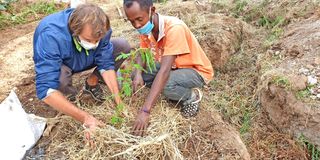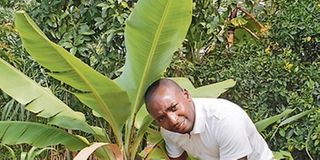Why not establish a food forest?

Jacob Terwitte, a permaculture trainer, helps a farmer plant crops. Farmers can optimise their land use by embracing the food forest concept, as it is a viable agribusiness, where they can earn money throughout the year. PHOTO | RACHEL KIBUI | NATION MEDIA GROUP
What you need to know:
- The farm is a sight to behold, with the farmer growing dozens of crops that include sweet potatoes, beans and vegetables such as black night shade.
- There is also maize, sugar cane, castor oil plants, oranges, mangoes, and avocado trees at various stages of growth. Surrounding the farm are various trees.
- Through the concept, one utilises space well including vertically, by growing climbers like passion fruits on the tall trees.
- A food forest has seven levels, including a canopy characterised by fruits and nuts trees, low tree layer that has dwarf fruit trees while shrub layer has currants and berries.
A drive to Lake Elementaita, off the Nakuru-Naivasha highway, is breath-taking.
The scenic view of the lake, coupled with lush green vegetation that stretches yonder, gives one peace of mind.
The lake is salty, thus one expects few farming activities in the area that is littered with dozens of tourist hotels and lodges.
Some 300 metres to the lake, the Seeds of Gold team takes a right turn, which leads to Charles Mwangi’s one-acre farm.
The farm is a sight to behold, with the farmer growing dozens of crops that include sweet potatoes, beans and vegetables such as black night shade.
There is also maize, sugar cane, castor oil plants, oranges, mangoes, and avocado trees at various stages of growth. Surrounding the farm are various trees.
“This is a food forest,” says Mwangi of the farming concept he practices. “I have everything that one may need on my one acre, from fruits to vegetables and cereals.”
Just like in a forest where one finds various kinds of trees and shrubs, under the concept, one grows a variety of plants and can keep small animals like ducks, geese and rabbits, which support the system by providing manure.
On this day, Mwangi is hosting 15 farmers from different counties who are here to learn from an international permaculture and organic farming trainer about food forest.
Jakob Terwitte, the permaculture trainer, says the aim of the concept is to enhance food and nutrition security, especially among smallholder farmers.
To establish a food forest, explains Terwitte, one grows different plants that have various uses.
MORE RESILIENT SYSTEM
These include those eaten for food, which have medicinal value, spices and trees that provide timber.
"If you already have other crops on the farm, you need to decide which ones to retain, like shrubs, fruits and timber trees. Do away with trees which produce chemicals that hinder other crops from thriving, for example, blue gum. Dig swales to allow spread of water for a length of up to 2-3 metres. Ensure there is a clear path, which you will be using to go to your farm. Plant nitrogen fixers, and fruit trees suitable for the area. Also plant herbs and spices," he says.

Charles Mwangi on his food forest farm in Nakuru. Just like in a forest where one finds various kinds of trees and shrubs, under the concept, one grows a variety of plants and can keep small animals like ducks, geese and rabbits, which support the system by providing manure. PHOTO | RACHEL KIBUI | NATION MEDIA GROUP
Through the concept, one utilises space well including vertically, by growing climbers like passion fruits on the tall trees.
A food forest has seven levels, including a canopy characterised by fruits and nuts trees, low tree layer that has dwarf fruit trees while shrub layer has currants and berries.
The concept, according to Terwitte, enables farmers to avoid mono-cropping and spread their risks on various crops.
“One, therefore, ends up with a more resilient system that even takes care of the soil as opposed to what mono-culture that is getting soils depleted,” says Terwitte
Peris Kamau, a training officer at Seed Savers Network, a community based organization that is supporting farmers to learn the concept, says a food forest ensures diversity thus better nutrition.
“The more crops farmers grow, the more there will be seed-saving and, thus, varieties of seeds which farmers can exchange,” says Peris.
She notes dozens of farmers from Nakuru, Baringo, Vihiga and Kisumu counties have been trained to use the concept.
She advises young people to optimise land use by embracing the food forest concept, as it is a viable agribusiness, where they can earn money throughout the year.


